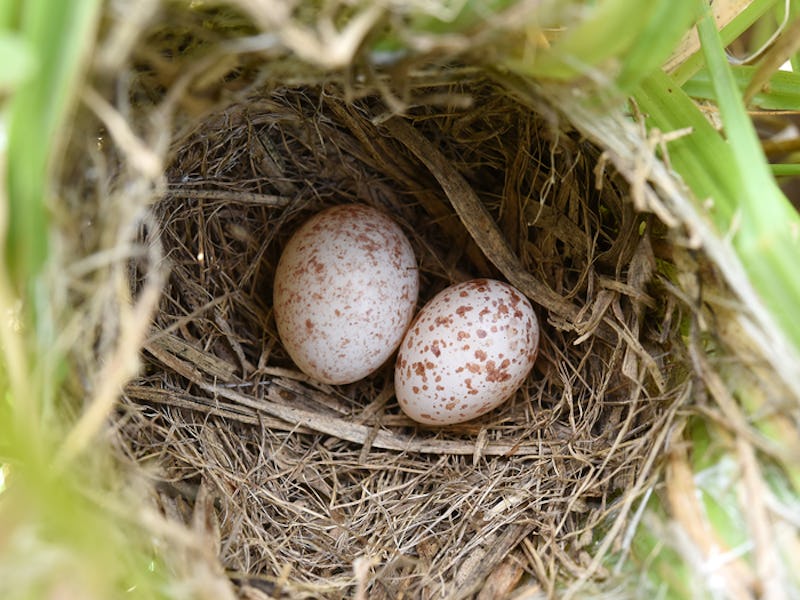Biologists have cracked the ‘long-standing mystery’ of egg mimicking in birds
Or, how to trick someone else into raising your kids (according to birds).

Easter eggs are wonderfully colorful and sometimes full of chocolate. While it remains an absolute mystery of nature how and why a rabbit lays and delivers these piebald, tasty eggs to children on Easter Sunday, another egg-citing mystery of the natural world has been poached — um, broached.
In a sinister example of natural selection, some birds are brood parasites, meaning a mother bird will lay her eggs in another bird’s nest for this stranger to raise. When the outsider chick hatches, it will try to kill the other chicks it must compete with for resources.
There are about 100 species of brood parasites. One of the mother bird’s tricks for slipping her eggs into other nests is her ability to produce eggs with all kinds of appearances. That way, she can convincingly mimic the eggs of the host.
What has perplexed ornithologists and evolutionary biologists for decades is how female cuckoos learn to lay this egg menagerie. If their offspring are consistently raised in families of different species, then those offspring interbreed with other males. And yet, generation after generation of female cuckoos inherit the ability to lay eggs with all sorts of appearances.
Researchers from the University of Cambridge, University of Cape Town, and Boston University have these imitators figured out. Having followed the African cuckoo finch brood parasite and one of its choice hosts, grass warblers, the team published their findings last week in the journal Proceedings of the National Academy of Sciences. While they’ve learned how cuckoo finches learn egg mimicry, they also learn why this adaptation isn’t a good strategy in the long run.
A tawny-flanked prinia, a common host species of the cuckoo finch, captured in Zambia for genetic sampling with the help of field assistant Tom Hamusikili.
What’s new — Female cuckoo finches pass down the ability to mimic the appearance of host family eggs with the female-specific W chromosome. In humans, the Y chromosome is male-specific, and in birds, the W chromosome is for females. This matrilineal ability keeps finches from possibly losing this ability due to interbreeding with a male of a different species. Since male cuckoo finches lack the W chromosome (and the ability to lay eggs), they don’t receive it.
This genetic trait endows female cuckoo finches with the ability to lay eggs with a broad range of colors and appearances. If the cuckoo egg closely resembles the host’s egg, then the host is much less likely to throw it out of the nest. Then, when the chicks all hatch, the cuckoo chick outcompetes its adoptive siblings for resources. In some cases, the host will raise the parasite while its biological chicks die. Diabolical? Sure. An innovation of natural selection? Absolutely.
“This very selfish strategy should be favorited by natural selection,” Claire Spottiswoode, an evolutionary biologist at the University of Cambridge and the study’s lead author, tells Inverse.
But why the deceit?
“I’m sure many of your readers won’t need any reminding that the costs of parenthood are quite substantial,” Spottiswoode jokes. The biological upside is that foisting your young upon other families allows even more reproduction. It’s actually quite easy to have lots of offspring when you don’t have to raise them.
Why it matters — This adapted trait has a downside, the researchers find. This downside is likely a big reason why there aren’t more brood parasites in the avian world.
“That would appear to be because the life of a cheat is actually not all that easy,” Spottiswoode says.
On the one hand, maternal inheritance lets cuckoo finches pull off these reverse kidnappings. On the other hand, it potentially stunts evolution for counter-adaptations as the hosts catch up. Some host species have a vast repertoire of egg color and signature patterns. The greater variety the host has in their own eggs, the harder it will be for the cuckoo finches to keep up.
The result is a greater and more dazzling array of egg colors and patterns, and more complex beauty in the shells that are all the harder for fakes to imitate. “As the parasite gets better at tricking the host, the host gets better at detecting whether it's been tricked, and you have this escalation of ever-better exploitation and ever-better defense between the two species,” Spottiswoode explains.
In the long run, the cheats will get what’s coming to them, evolutionarily speaking. Cuckoo finches cannot regain different forgery capabilities their relatives may possess. For instance, two distinct lineages of female cuckoo finches may have evolved to mimic eggs with blue or red shells, but lack the ability to also produce olive-green eggs that some host mothers produce. It appears authenticity wins out.
Cuckoo finch and host chicks. Brood parasitism is costly for hosts because a cuckoo finch chick begs for food very vigorously as soon as it hatches, outcompeting the host parents’ own chicks (here zitting cisticolas) which typically soon die of starvation.
What’s next — Spottiswoode’s questions turn to the specific genes involved in this trait. In a next step that resembles the ending of the 2002 film Catch Me If You Can, the researchers now want to figure out how these brood parasites are so skilled at making good egg forgeries.
“They’re not perfect by any means, but they’re still pretty damn good,” she says. On the other side of this game of one-upsmanship, Spottiswoode also wants to see which genes allow for hosts to produce more and more signature egg appearances.
Of course, this is much less of a problem for humans. On Easter one will find myriad egg forgeries, and also a roasted egg on the Passover Seder plate, but won’t require the same acumen as grass warblers. It’s easy to spot an egg fraud if it’s made of solid milk chocolate.